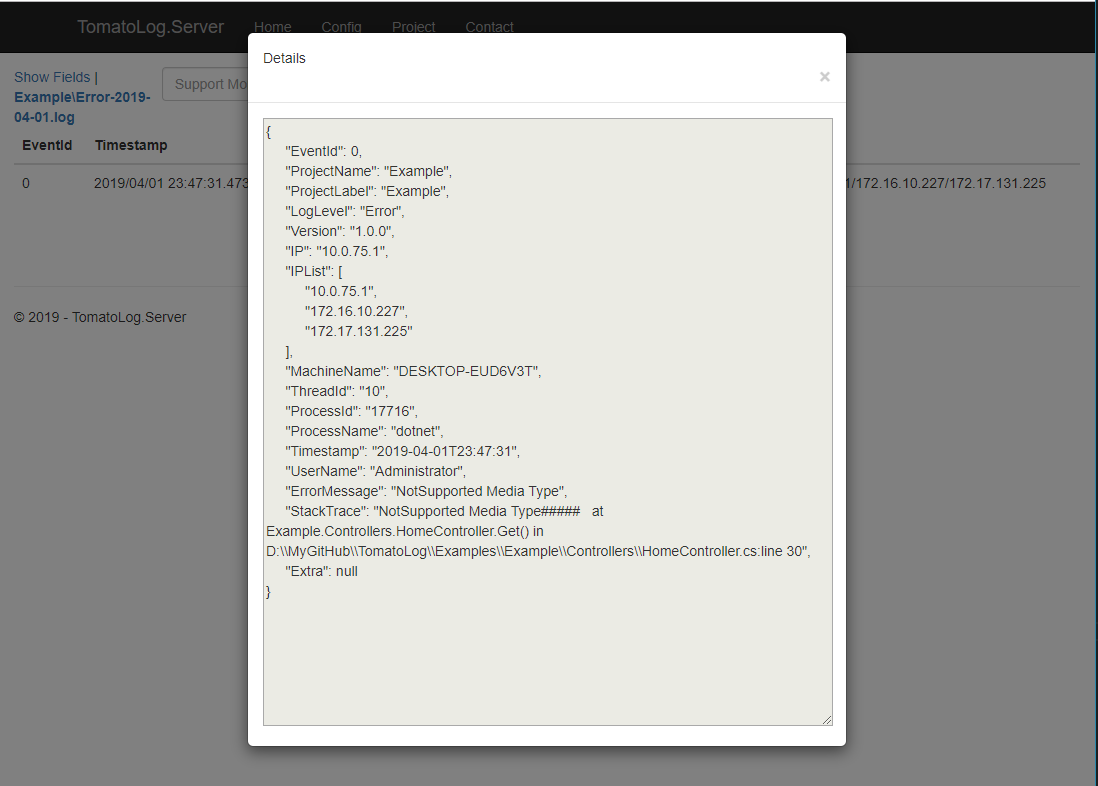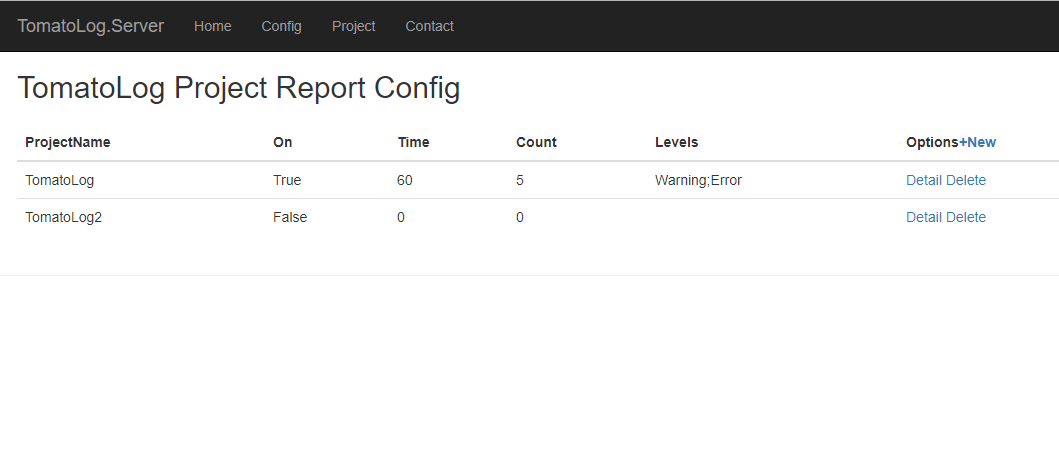客戶端實現了ILoggerFactory,使用服務註入成功後即可使用,對業務入侵非常小,也支持通過客戶端調用寫入日誌流。 ...
TomatoLog
TomatoLog 是一個基於 .NETCore 平臺的產品。
The TomatoLog 是一個中間件,包含客戶端、服務端,非常容易使用和部署。
客戶端實現了ILoggerFactory,使用服務註入成功後即可使用,對業務入侵非常小,也支持通過客戶端調用寫入日誌流。
TomatoLog 的客戶端和服務端目前都是基於 .NETCore 版本,客戶端提供了三種日誌流傳輸方式,目前實現了 Redis/RabbitMQ/Kafka 流。如果希望使用非 .NETCore 平臺的客戶端,你可以自己開放其它第三方語言的客戶端,通過實現 TomatoLog 傳輸協議,將數據傳送到管道(Redis/RabbitMQ/Kafka)中即可。
TomatoLog 服務端還提供了三種存儲日誌的方式,分別是 File、MongoDB、Elasticsearch,存儲方式可以通過配置文件指定。在 TomatoLog 服務端,我們還提供了一個Web 控制台,通過該控制台,可以對日誌進行查詢、搜索,對服務過濾器進行配置,警報配置、通知發送等等,其中,可使用的警報通知方式有:SMS 和 Email 兩種方式,但是,SMS 其本質是一個 Http 請求,通過 SMS 的配置,可以實現向所有提供了 Http 介面的網關發送通知。
TomatoLog 系統架構

Get Started
使用客戶端
選擇安裝以下客戶端中的任意一項
Install-Package TomatoLog.Client.Redis
Install-Package TomatoLog.Client.RabbitMQ
Install-Package TomatoLog.Client.KafkaTomatoLog客戶端配置文件 appsetting.json
{
"TomatoLog": {
"LogLevel": "Information",
"ProjectLabel": "Example",
"ProjectName": "Example",
"SysOptions": {
"EventId": true,
"IP": true,
"IPList": true,
"MachineName": true,
"ProcessId": true,
"ProcessName": true,
"ThreadId": true,
"Timestamp": true,
"UserName": true
},
"Tags": null,
"Version": "1.0.0",
"Exchange": "TomatoLog-Exchange",
"ExchangeType": "direct",
"Host": "127.0.0.1",
"Password": "123456",
"Port": 5672,
"QueueName": "TomatoLog-Queue",
"RouteKey": "All",
"UserName": "lgx",
"vHost": "TomatoLog"
}
}服務註入
public void ConfigureServices(IServiceCollection services)
{
services.AddSingleton<ITomatoLogClient>(factory =>
{
var options = this.Configuration.GetSection("TomatoLog").Get<EventRabbitMQOptions>();
var client = new TomatoLogClientRabbitMQ(options);
return client;
});
...
}配置啟用
public void Configure(IApplicationBuilder app, IHostingEnvironment env, ILoggerFactory factory, ITomatoLogClient logClient)
{
factory.UseTomatoLogger(logClient);
...
}使用 TomatoLogClient
[Route("api/[controller]")]
[ApiController]
public class HomeController : ControllerBase
{
private readonly ITomatoLogClient logClient;
private readonly ILogger logger;
public HomeController(ILogger<HomeController> logger, ITomatoLogClient logClient)
{
this.logger = logger;
this.logClient = logClient;
}
[HttpGet]
public async Task<ActionResult<IEnumerable<string>>> Get()
{
// Used by ILogger
this.logger.LogError("測試出錯了");
// Used By ITomatoLogClient
try
{
await this.logClient.WriteLogAsync(1029, LogLevel.Warning, "Warning Infomation", "Warning Content", new { LastTime = DateTime.Now, Tips = "Warning" });
throw new NotSupportedException("NotSupported Media Type");
}
catch (Exception ex)
{
await ex.AddTomatoLogAsync();
}
return new string[] { "value1", "value2" };
}
}部署服務端
首先,下載服務端壓縮包文件 版本預覽 ,該壓縮包僅包含項目運行必需文件,托管該服務端的伺服器上必須按照 DotNET Core SDK 2.2+
接下來,解壓文件,修改 appsetting.Environment.json 文件將伺服器進行配置,將配置好的服務端部署到你的伺服器上,可以為 TomatoLog 選擇 IIS 或者其它托管方式,服務端預設運行埠為:20272.
編輯服務端配置文件
{
"Logging": {
"IncludeScopes": false,
"LogLevel": {
"Default": "Debug",
"System": "Information",
"Microsoft": "Information"
}
},
"TomatoLog": {
"Cache-Redis": null, // 過濾器會使用該分散式緩存進行策略考量,如果有配置
"Config": {
"SysConfig": "Config/SysConfig.json" // 系統配置文件,可通過Web控制台進行配置
},
"Storage": {
"Type": "ToFile", //ToFile/ToES/ToMongoDB 可以選擇的存儲方式
"File": "D:\\TomatoLog\\Storage", // 如果Type選擇了 ToFile ,則這裡必須指定絕對路徑
"ES": "http://127.0.0.1:9200/", // 如果Type選擇了ToES,這裡必須配置 Elasticsearch 服務地址
"MongoDB": "mongodb://root:[email protected]:27017/admin" //如果Type選擇了ToMongoDB,這裡必須配置 ToMongoDB 資料庫鏈接
},
"Flow": {
"Type": "RabbitMQ", // Redis/RabbitMQ/Kafaka 這裡指定客戶端和伺服器的傳輸管道類型,兩端配置必須一致
"Redis": {
"Connection": null,
"Channel": "TomatoLogChannel"
},
"RabbitMQ": { // 如果使用了 RabbitMQ,則必須配置該節點
"Host": "127.0.0.1",
"Port": 5672,
"UserName": "root",
"Password": "123456",
"vHost": "TomatoLog",
"Exchange": "TomatoLog-Exchange",
"ExchangeType": "direct",
"QueueName": "TomatoLog-Queue",
"RouteKey": "All",
"Channels": 1 // 運行的消息隊列實例數量
},
"Kafka": {
"Group": "TomatoLogServer",
"BootstrapServers": "127.0.0.1:9092",
"Topic": "TomatoLog"
}
}
}
}
番茄日誌服務端控制台長什麼樣
在瀏覽器中打開地址:http://localhost:20272/
首頁看日誌列表

日誌詳情、彈出查看詳情、日誌搜索、支持ES/MongoDB/File搜索

全局日誌處理、警報配置

針對單個項目的詳細日誌處理、警報配置

一次打包,到處運行
不管是從項目結構還是解決方案,我都強調簡單就是最美的根本要求,解決方案的內容雖然看起來很多,但是你也只需要按需引用其中一個客戶端就可以了,服務端更是如此,全站都打包在一個 .NETCore 的應用程式中,程式的警報配置都是存儲在配置文件中的,無需資料庫支持。


